 Society
Society


|
| Teacher and Banar ethnic minority students at Đặng Trần Côn Primary School, in Ngọc Bay Commune, Kon Tum City. VNA/VNS Photo |
KON TUM A new project to enhance language skills for ethnic minority children has been hailed a success.
Youngsters in the Central Highlands province of Kon Tum have been improving their skills for the past five years since the scheme was launched.
So successful has it been, plans are in the pipeline to extend it for a further five years in the region.
According to Đinh Thị Lan, Deputy Director of the provincial Department of Education and Training, localities have been creative in implementing Vietnamese language enhancement for children, especially pre-schoolers, in accordance with the situation in each area.
Currently, the province has 22,600 ethnic minority pre-school children who are improving their Vietnamese language skills at 136 kindergartens.
In the current school year (2020-2021), the provincial education sector was maintaining and improving the quality of both pre and primary school education and building national standard schools, especially for ethnic minority areas.
The teaching project aims to ensure that ethnic minority children have basic skills in Vietnamese to be able to complete the Ministry of Education and Training’s preschool and primary education programme, as well as create a premise for them to learn the next levels.
Bằng Lăng Kindergarten in Vinh Quang Commune, Kon Tum City, has 267 children, mostly Banar ethnic group (66 per cent).
School administrators determined that teaching Vietnamese to ethnic minority children played an important role in helping them learn lessons, said principal Nguyễn Thị Phúc Tiệp.
From the beginning of the 2020-21 school year, it has improved room facilities, trained teachers professionally, and co-ordinated with parents to increase communication in Vietnamese with children at home.
Tiệp said: “The biggest difficulty in teaching Vietnamese in class is the language barrier between teachers and students, especially for the three-year-old children, their first year at kindergarten.
“Before, they only used their own ethnic minority language when communicating with their parents and families at home.
“When they first come to school, they do not understand what the teacher is saying so they will be passive and less communicative.
“In addition, a number of young teachers still lack experience, so are confused when meeting difficulty with those who speak a different language.”
Experienced teachers often shared their knowledge with young colleagues, encouraging them to actively participate in ethnic language classes, and exchange out of school with students' parents.
The school has received support from parents, and the local authorities.
“We are happy to see the number of children going to school regularly has increased, especially ethnic minority children attending school every year,” the principal said.
Đặng Trần Côn Primary School, in Ngọc Bay Commune, Kon Tum City, has 500 students, all Banar ethnic minority group.
Of that, 106 students in grade one were at high risk of dropping out of school, because many of them did not know Vietnamese.
Đậu Thị Lan, the school’s principal said its executive board had increased teaching Vietnamese in class weekly for both teachers and students.
It regularly organised outdoor activities to create an environment and opportunities for children to play and communicate with Vietnamese pupils.
Lan said: “So far 100 per cent of students can use Vietnamese to communicate in class. We also encourage children to speak more at home with family members.”
The provincial Department of Education and Training also admitted that mobilising ethnic minority children to school in some upland districts, lack of preschool teachers and poor infrastructure at classroom were immediate difficulties.
The Ministry of Education and Training continually implemented support regimes for preschool teachers and children, allocating enough teachers and giving priority to investment in infrastructure for the province. VNS




